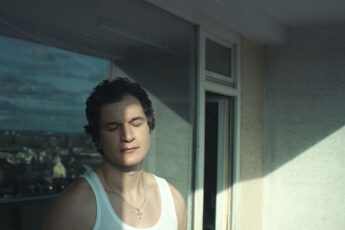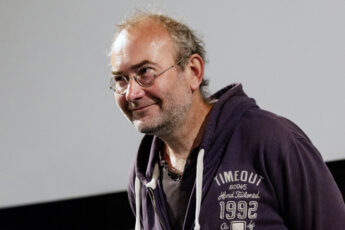On the Banality of Evil
Bohdan Sláma’s Shadow Country (Krajina ve stínu, 2020)
Vol. 108 (October 2020) by Isabel Jacobs
Bohdan Sláma’s new film Shadow Country is a black-and-white historical drama inspired by true events unfolding in May 1945. The epic narrative of 135 minutes chronicles the aftermath of World War II through the lens of a small village community in the Czech borderlands. Shot in Sláma’s home village Bořice, the film explores the fictional village Schwarzwald, a multi-ethnic community of Czech, Austrian, German and Jewish families. Showing multiple perspectives of the different villagers, the film captures the occupation of the village by the Nazis, the deportation of Jews and Communists, and finally the expulsion and killing of its German population after the end of the war.
The first hour is a psychologically dense exploration of the events preceding World War II which lead to the annexation of the small village by Nazi Germany. The part set during the war is an accelerated and rather allusive version of a story that cinema has repeatedly retold: the persecution and deportation of Jews and Communists, ideological struggles between conformism and resistance, the tragic death of young men on the battlefields, and an overall climate of terror. Sláma treats the events during wartime as a kind of suspenseful prologue to the last two thirds of his film which culminate in the execution of German residents after the war. The turning point of the story is thus the moment when the Czech villagers take their German neighbors to a basement and, as Sláma puts it, do what one would be afraid that they would do.
Shadow Country’s plot is inspired by the massacre of Sudeten Germans in the village Tust’ in May 1945, a topic which might be unknown to most international viewers. After the end of World War II, Czechoslovak president Edvard Beneš, deliberately mirroring the Nazis’ atrocious jargon for the Holocaust, announced the “final solution of the German question.” Throughout the following months several millions of ethnic Germans were expelled from Czechoslovakia, thousands of whom died during this violent deportation. In villages across the country, brutal massacres of the German population took place.
Against this historical background, screenwriter Ivan Arsenjev developed Shadow Country’s script over the course of 14 years. Sláma’s own personal experience of living in a village seems to transform this historical sujet into a contemporary drama that is definitely worth watching. The opening scene looks like an eerie reference to Béla Tarr’s cult film Sátántangó, similarly an exploration of village life. Like Tarr, Sláma opens with a long shot on one of the farmhouses, prominently starring some cows. Steam rises from the meadows, the soundscape is a surreal cacophony of the cows’ lowing, the overly sharp crackling of burning fire and the sounds of bells and milk jugs and a tree which is moved by the wind.
Already this very first scene sets the tone for the whole two-and-a-half hours. Throughout the entire film, the director manages to find a well-composed balance between cinematographer Diviš Marek’s long, slow and beautifully arranged shots and a symphonic soundscape which doesn’t intrude, but subtly enhances the images with intensity and suspense. Sláma decided to shoot Shadow Country without using contact sound to create “shots with this perfect silence.” This way of shooting, as the director tells me, gave him much more freedom, because “you are more connected with every scene.” The viewer equally feels more freedom to fully concentrate on the characters and their emotions. There seems to be a lot of space for us viewers in Sláma’s film, space for our own thoughts, feelings, and ambiguities. Completely soaked into Shadow Country’s candid images, we become active participants who will obtrusively ask ourselves how we would have felt and acted in a similar situation.
The decision to post-synchronize the film also had the pragmatic reason that the Czech actors had to speak in a very specific German dialect of the village at that time. The fact that they had to learn and meticulously stage every single line gives the dialogues in German, in contrast to the Czech ones, a certain artificialness. This can’t be said about the acting, though, which is generally impressive, especially Magdaléna Borová’s powerful performance as Maria Veberová, a Czech woman who is married to an indecisive and spineless German (Stanislav Majer) who later falls victim to the village’s lynch mob.
Throughout the film, the different ideological tokens are embodied in the banal objects of everyday life, from Maria’s Singer sewing machine over wallpapers, photographs, furniture, teacups, and a puppet theater. In a beautiful scene of resistance, Maria is sewing swastika symbols on flags, only to realize that she applied the patches back-to-front: a subtle subversion of power’s icons. While the men are generally drawn into events as powerless individuals who are easily corrupted by leading opinions, it’s the women who are, quite literally, “sewing history.” The antithesis to Maria’s moral integrity is Marta Lišková (Bára Poláková), an enthusiastically deluded Nazi propagandist who uses her radiant beauty to popularize the new regime in the village community. In the course of the film, Marta will be humiliated, raped and finally killed. Together, the two women generate the field of tension in which the violent and tragic events slowly unfold.
Sláma describes the making of the film as a “cooperative project”, in which the actors were creatively involved in a spontaneous and collective process of storytelling. Their interaction is never clumsy or artificial, but always a perfectly composed group picture. Like in a cinematic choreography, several people are arranged in constellations reflecting different individual perspectives within the collective. The individual is shown in relation to the whole of the community. The reduced aesthetics of black-and-white with its focus on contrasts and space enable the viewers to feel very close to the characters and their emotional struggles. As in Michael Haneke’s historical drama film Das weiße Band, set in a small Protestant village in Northern Germany on the verge of World War I, Shadow Country’s aesthetic minimalism and the constant presence of others evoke feelings of claustrophobia, surveillance and paranoia.
Another figure worth mentioning is Communist Josef Pachl (Csongor Kassai), who in the end supervises his neighbors’ execution after having lost his Jewish wife and surviving several traumatic years in different concentration camps. Like in every epic, the question of revenge arises. Josef, wounded and radicalized by loss and trauma, returns to the village to restore justice: “I saw innocent people tortured and killed. Every time they took them to be executed, they begged me to one day take revenge.” It’s Josef, blindly following the orders of the new regime, who leads the village into violently executing their own neighbors and friends. Josef’s daughter leaves the village in the end, refusing to share her home any longer with a father broken by loss and guilt.
Shadow Country suggests that there is no such thing as cathartic revenge. According to the director, revenge can never be just. The true evil, Sláma’s film suggests in the spirit of Hannah Arendt, is not to think for ourselves and to sacrifice our neighbors, friends and family for the sake of prefabricated and abstract values. Shadow Country isn’t just a reflection on history, it’s a plea to contemporary viewers to think for themselves. Like this small Czech village, our society is an ambiguous patchwork of different ideologies, perspectives, and systems of value. By opening up a complex perspective on Czech post-war history, Shadow Country can also be watched as a wider exploration of collective responsibility, truth and justice. It’s a truly contemporary drama that leaves an impression by using adventurous sound and cinematography to tell a convincing story to which we can all relate.




Leave a Comment